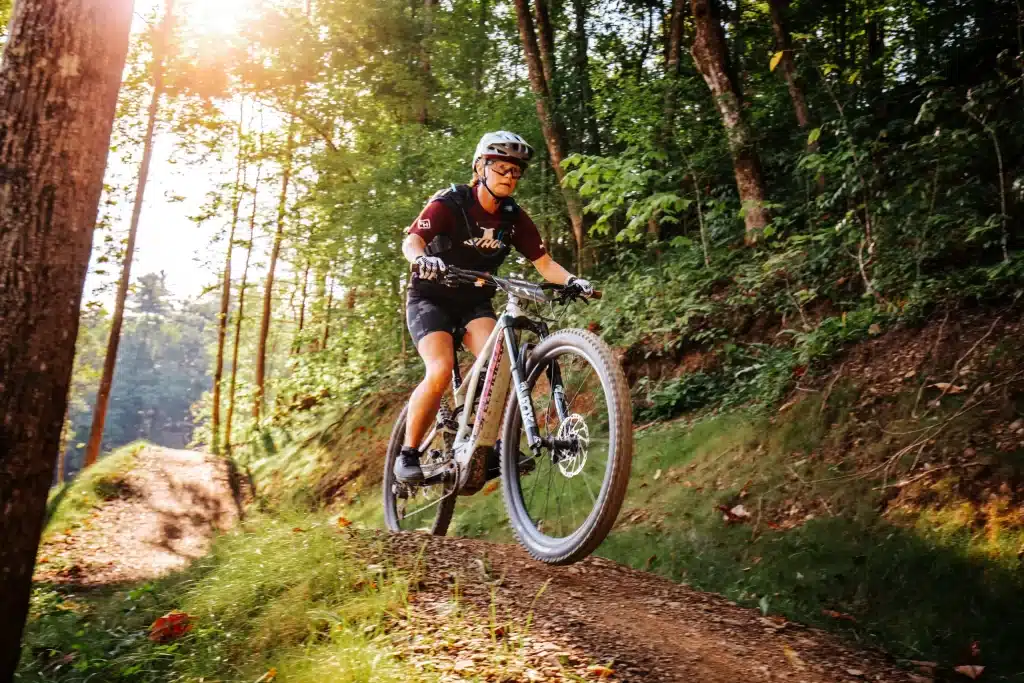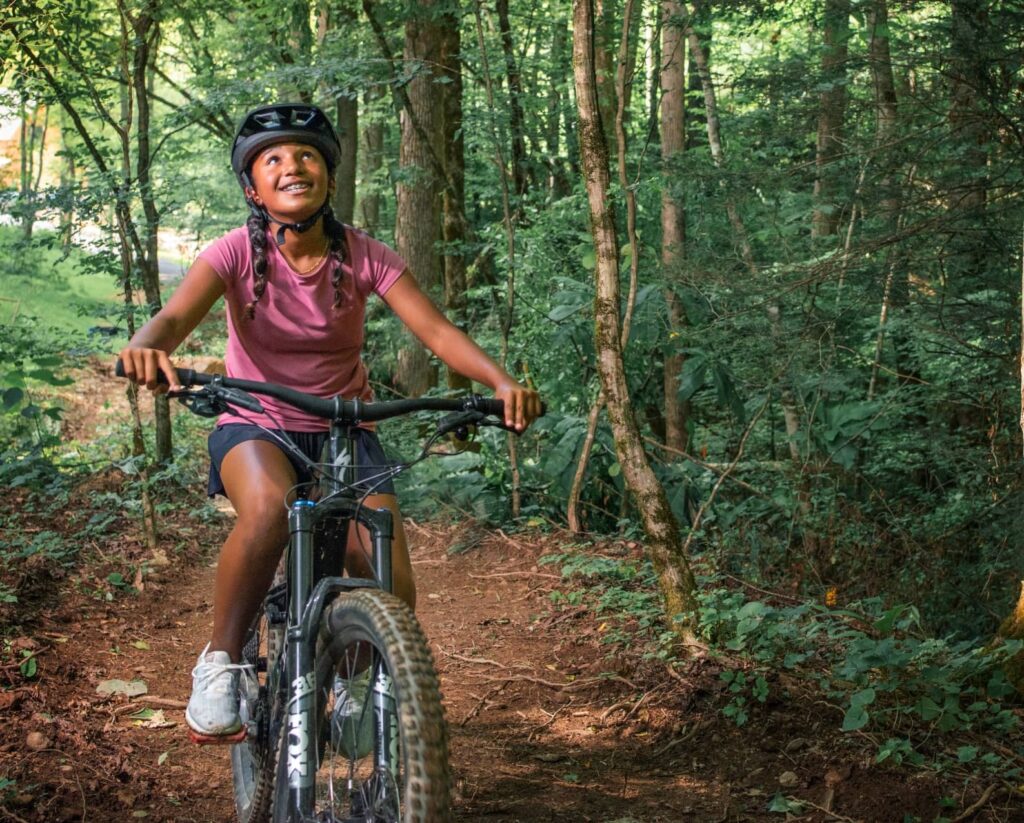If you’re new to mountain biking, you might be wondering about what you should wear when you go out for a ride. With the right MTB clothes for the time of year and weather, you can make sure your ride is comfortable and safe. As you get all of your mountain biking gear together, learn more about the right clothes for mountain biking by season.
Mountain Biking Gear That Won’t Change by Season
Regardless of the season, there are a few pieces of mountain biking clothing that won’t change. Below, you can review the essential pieces of mountain biking gear and clothes you’ll want to wear year-round:
Helmet
Even when it’s hot out, wearing a helmet is non-negotiable for safety. Before you buy a helmet, check if it has a Virginia Tech STAR rating or a rating from another trusted safety rating system. The best helmets should have MIPS (Multi-Directional Impact Protection System), ventilation, and adjustable visors that can deflect sun or debris. For additional protection, a full-face helmet is a solid choice.
Gloves
MTB gloves help riders maintain a strong grip on the handles by wicking away sweat, and they protect your hands from cuts or scrapes during falls. Typically, full-finger gloves are best for most times of the year since you want as much protection as possible, but in the summer, you may want to wear lightweight mesh gloves for greater comfort.
Flat or clipless shoes
If your bike’s pedals don’t have clips, you’ll need to wear flat pedal shoes. These shoes have a rubber sole with more grip strength than normal shoes and are stiff enough to keep your feet supported. When you have pedals with clips, go with clipless shoes (despite the confusing name, clipless shoes are those that clip in).
Protective gear
While some riders may not wear a lot of protective padding, it’s usually recommended for MTB riders, especially beginners. Common options for protective gear include elbow pads, knee pads, and chest or back protection. In general, you can stick with lighter padding on trail or cross-country rides, but should have thicker padding for all-mountain, enduro, downhill, or bike park rides due to the higher risk of injury.
Reflective vest/flashing lights
Reflective vests or flashing lights are a staple for night riding MTB clothing, and for good reason. If you plan to ride during low-light conditions, make sure to wear a reflective vest or have flashing lights to make sure you’re highly visible to other riders. Being more noticeable can also help if you take a fall and need assistance.
Sunglasses or goggles
Wraparound sunglasses with good side coverage work best for most trail rides and variable light, with photochromic or high-contrast lenses helping in forests and changing sun. Goggles make more sense in dust, cold wind, steady rain, or bike-park laps, and they pair well with full-face helmets.
MTB Outfits by Season
Though some gear won’t change by season, you’ll likely want to vary some of your mountain biking attire by the season. Below, you can find our guide to what to wear for mountain biking based on the time of year:
What to Wear Mountain Biking in the Spring
Spring mountain bike clothing is all about layering and being prepared for colder or rainy conditions. Review the primary clothes to wear during the spring below:
- MTB base layer: A close-to-skin top made out of Merino wool or a synthetic knit (polyester or nylon) manages sweat on climbs and limits chill on descents/ Merino wool also adds odor resistance and steady temperature regulation, while light grid-fleece versions earn their keep on cold starts.
- Mid-layer jersey: A breathable long-sleeve jersey or a short-sleeve jersey paired with arm warmers creates modular warmth that you can fine-tune as the day swings from cool to mild; rear-pocket storage is handy if you ride without a pack.
- Waterproof MTB jacket: A lightweight, waterproof, and breathable shell with a cycling cut (longer tail, articulated shoulders, helmet-compatible hood) is a good choice for rainy days. These jackets block showers and wind while venting well enough to keep you from overheating on climbs.
- MTB shorts or tights: Durable, stretch-woven shorts with a longer inseam pair well with knee or leg warmers for dawn rides. On colder days, thermal tights or lined trail pants replace the liner shorts to keep quads and knees warm.

If you plan to ride in Tennessee, keep in mind that spring ticks are active in brushy trail edges. Treat socks and outer layers with 0.5% permethrin at home, use an EPA-registered repellent on exposed skin, and wash trail clothes after rides to remove poison ivy oil and other irritants you might have picked up on your ride.
What to Wear Mountain Biking in the Summer
While you may need to occasionally throw on an additional layer in the summer, hot-weather mountain biking clothing is fairly minimal. Below, you can review the primary summer mountain bike apparel to wear on hot days:
- Short-sleeve MTB jersey: Lightweight, quick-dry knits in light colors reduce heat absorption, and micro-perforations or mesh panels improve airflow on humid climbs. Sun sleeves or airy long sleeves can also add UV protection without much heat gain.
- MTB shorts: Breathable, fast-dry fabrics with a secure, adjustable waistband keep movement smooth. If your route includes rougher descents, look for MTB shorts with a slightly longer inseam to help with brush protection and avoid gaps over knee pads.
- Packable rain shell: A featherweight, packable rain shell that actually breathes turns surprise pop-up showers into a non-issue, and it doubles as a wind layer when ridge breezes pick up late in the day.

In forested zones like the Smokies, you might want to wear longer socks and light long sleeves to reduce skin contact with ticks and poison ivy. It’s also a good idea to wear bright colors to improve daytime visibility. If you’re riding near sunset or at sunrise, add a reflective vest to make sure other riders can see you.
What to Wear Mountain Biking in the Fall
Like in the spring, fall mountain biking clothing often involves layering to prepare for changing temperatures and weather conditions. Review the primary types of fall MTB gear below:
- Base layer: Merino wool or mid-weight synthetic long sleeves balance warmth with moisture transfer during cool mornings and shaded climbs, limiting sweat chill when you stop.
- Mid-layer jersey: A thin fleece or long-sleeve jersey adds steady warmth without bulk, and it works well under a shell when drizzle or wind shows up.
- Waterproof MTB jacket: A breathable, rain-ready shell with pit-zips or rear vents manages leaf-spray, mist, and gust.
- MTB pants or tights: Thermal pants or long tights with tapered cuffs block wind and brush, stay clear of the drivetrain, and keep knees warmer on long descents and shuttle days.
- Knee or leg warmers: Easy-on warmers bridge shoulder-season swings, starting warm for morning roll-outs and stashing small once the sun does its work.
Ticks can remain active into late fall in Tennessee. Keep using repellent and do a quick tick check post-ride.

What to Wear Mountain Biking in the Winter
Typically, you’ll want to wear the following cold-weather mountain biking gear during the winter:
- Thermal base layer: Mid-weight Merino wool or brushed synthetic tops should be the base of your winter mountain biking clothing. These tops trap heat while moving sweat off skin, reducing the clammy chill that ends rides early.
- Insulating mid-layer: A light fleece or breathable softshell holds warmth on descents yet vents under effort, giving you insulation without bulky weight.
- Winter MTB jacket: A wind-resistant, water-resistant or waterproof outer layer with effective venting (zips or back yoke) controls heat build-up on climbs while sealing out sleet and spray.
- Thermal MTB pants: Insulated or lined trail pants that shed slush and mud keep legs comfortable, and articulated knees preserve pedal stroke efficiency in cold air.
While you won’t need to worry about ticks during the winter, the sun does go down earlier, and the weather can impact visibility. As a result, reflective bands on ankles or knees are essential for ensuring your visibility to drivers and other trail users, but always pair reflective clothing with front and rear lights.
MTB Clothing Tips for Kids
While the tips above apply to children as well, we also like to recommend the following additional tips for dressing kids for mountain biking:
- Visibility: Make sure kids wear brightly colored gear with reflective elements to enhance visibility, especially in low-light conditions.
- Extra layers: Keep extra layers on hand for kids, as they can get cold faster. Consider adding thin liner gloves for comfort on longer rides.
- Practice with gear: Before heading out, have kids practice wearing all their gear to ensure it’s comfortable and functional.

What to Pack for Mountain Biking
Alongside wearing the right MTB clothing, it can be a good idea to pack a bag full of items that you might need during or after your ride.
- Hydration system: A hydration pack covers longer or hotter rides with space for tools and layers, while a bottle setup is efficient for short loops. Electrolyte tabs can also help on humid days.
Weather layer: A stowable wind or rain shell should live in the pack year-round to help you continue riding in wet weather. - Repair kit: A mini pump or CO₂, tire levers, tube or tubeless plugs, a multi-tool, and a spare quick-link address the most common trail fixes without weighing you down.
- Safety and nav: A small first-aid kit, a charged phone, a whistle, and a compact headlamp provide a margin of safety if a route runs long or a mechanical issue slows you down.
- Nutrition and skin care: Quick calories, electrolyte chews, sunscreen, lip balm, and bug repellent suit most rides. When you ride on Tennessee trails, making tick-aware choices and post-ride clothing wash-throughs are a great extra step to take.
Go Mountain Biking in the Smokies at WildSide
If you’re looking for mountain biking trails in Pigeon Forge, TN, WildSide has you covered. No matter the time of year, our visitors can enjoy our 20 mountain biking trails that cover 11+ miles and range in difficulty from beginner to expert only. We also have a jump park for adrenaline seekers, a mix of standard and electronic mountain bikes for rent, and classes for beginners!
Learn more about our mountain biking trails and jump park today. If you’re interested in renting one of our bikes, please review our options.